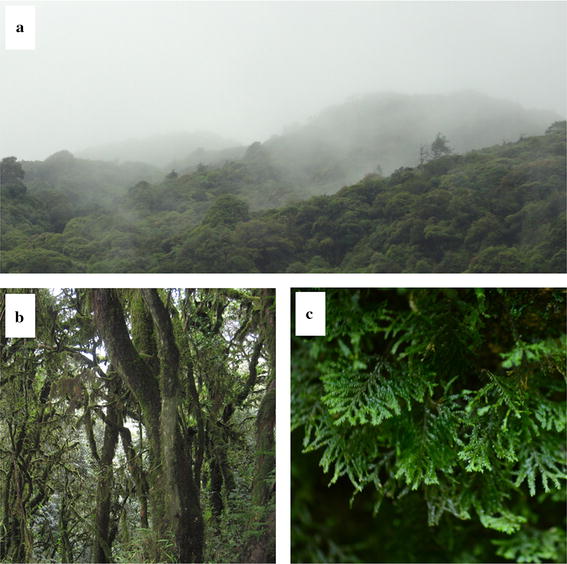Fan life forms are bryophytes with shoots raising from a vertical substratum that branch repeatedly in the horizontal plane to form flattened photosynthetic surfaces. This type of bryophyte usually “stands” on tree trunk surfaces and has a very extensive surface area in contact with the air, which are well suited for intercepting water from moving air. However, detailed water relations and gas exchange characteristics of fan bryophytes and their adaptations to particular microhabitats are still poorly understood.
Prof. LIU Wenyao and his team of Xishuangbanna Tropical Botanical Garden (XTBG) conducted a study in an Asian subtropical montane cloud forest (SMCF) in the Xujiaba region of Ailao Mountains (24°32′N, 101°01′E) in Yunnan Province. The researchers quantified microclimatic characteristics of fan bryophyte microhabitats. They also studied water relations (water release curves, pressure–volume relationships) and photosynthetic water and light responses of three representative fan bryophytes (Homaliodendron flabellatum , Plagiochila arbuscula , and Plagiochila assamica).
They addressed the questions of what the water and light conditions are at locations occupied by fan bryophytes and how the environmental conditions influence their water and carbon balances. They then studied the water retention and desiccation tolerance capacities and the response of carbon assimilation to changes in shoot water content and photosynthetically active radiation.
The study found that there are high relative humidity but low light levels and temperatures in the understory. The fog helps maintain relatively high water availability during most of the year for tree trunk fan bryophytes. The fan bryophytes have limited water retention capacities but have developed relatively high cell wall elasticity and osmoregulation capacity so as to tolerate desiccation. In addition, relatively low light saturation and compensation points may help them tolerate shaded tree trunk microhabitats.
They also found that the carbon gain of fan bryophytes is highly water-dependent. Therefore, fan bryophytes can flourish on tree trunks because of heavy annual precipitation, high average relative humidity, and frequent and long duration of fog, which provide continuous water supplies for them to intercept.

a .The subtropical montane cloud forest in the Ailao Mountains;
b. abundant epiphytic bryophytes in the understory;
c. fan bryophyte Plagiochila assamica Steph.
(Photo credit: Liang Song)
Contact
SONG Liang Ph.D
Key Laboratory of Tropical Forest Ecology, Xishuangbanna Tropical Botanical Garden, Chinese Academy of Sciences, Mengla, Yunnan 666303, China
Tel: 135 2915 5140
Fax: 86 691 8715070
E-mail: songliang@xtbg.ac.cn
Key Words
Fan bryophytes, moss, subtropical montane cloud forest, microhabitat, Ailao mountains, adaptation

